Page 45 of 414
A forward-facing child seat (C-E) provides restraint for
the child’s body with the harness and also sometimes
with surfaces such as T-shaped or shelf-like shields.A booster seat (F-G) is a child restraint designed to
improve the �t of the vehicle’s safety belt system. Some
booster seats have a shoulder belt positioner, and
some high-back booster seats have a �ve-point harness.
A booster seat can also help a child to see out the
window.
1-39
Page 46 of 414
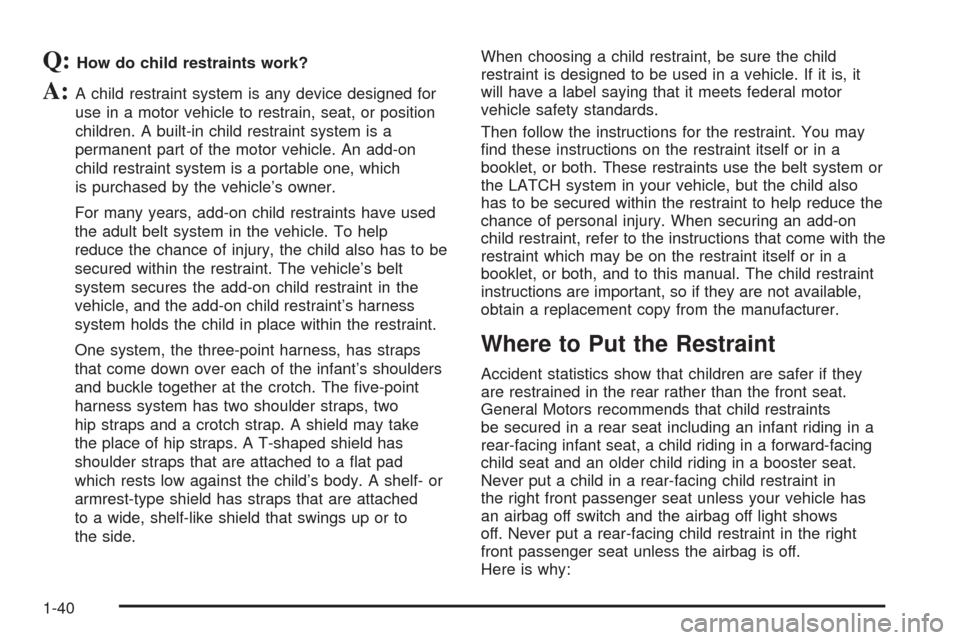
Q:How do child restraints work?
A:A child restraint system is any device designed for
use in a motor vehicle to restrain, seat, or position
children. A built-in child restraint system is a
permanent part of the motor vehicle. An add-on
child restraint system is a portable one, which
is purchased by the vehicle’s owner.
For many years, add-on child restraints have used
the adult belt system in the vehicle. To help
reduce the chance of injury, the child also has to be
secured within the restraint. The vehicle’s belt
system secures the add-on child restraint in the
vehicle, and the add-on child restraint’s harness
system holds the child in place within the restraint.
One system, the three-point harness, has straps
that come down over each of the infant’s shoulders
and buckle together at the crotch. The �ve-point
harness system has two shoulder straps, two
hip straps and a crotch strap. A shield may take
the place of hip straps. A T-shaped shield has
shoulder straps that are attached to a �at pad
which rests low against the child’s body. A shelf- or
armrest-type shield has straps that are attached
to a wide, shelf-like shield that swings up or to
the side.When choosing a child restraint, be sure the child
restraint is designed to be used in a vehicle. If it is, it
will have a label saying that it meets federal motor
vehicle safety standards.
Then follow the instructions for the restraint. You may
�nd these instructions on the restraint itself or in a
booklet, or both. These restraints use the belt system or
the LATCH system in your vehicle, but the child also
has to be secured within the restraint to help reduce the
chance of personal injury. When securing an add-on
child restraint, refer to the instructions that come with the
restraint which may be on the restraint itself or in a
booklet, or both, and to this manual. The child restraint
instructions are important, so if they are not available,
obtain a replacement copy from the manufacturer.
Where to Put the Restraint
Accident statistics show that children are safer if they
are restrained in the rear rather than the front seat.
General Motors recommends that child restraints
be secured in a rear seat including an infant riding in a
rear-facing infant seat, a child riding in a forward-facing
child seat and an older child riding in a booster seat.
Never put a child in a rear-facing child restraint in
the right front passenger seat unless your vehicle has
an airbag off switch and the airbag off light shows
off. Never put a rear-facing child restraint in the right
front passenger seat unless the airbag is off.
Here is why:
1-40
Page 52 of 414
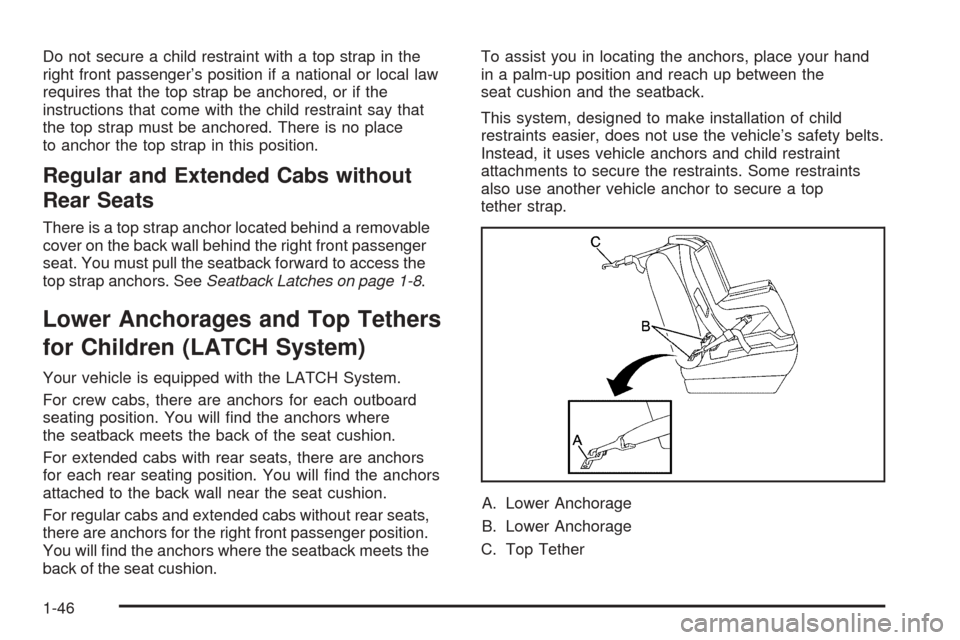
Do not secure a child restraint with a top strap in the
right front passenger’s position if a national or local law
requires that the top strap be anchored, or if the
instructions that come with the child restraint say that
the top strap must be anchored. There is no place
to anchor the top strap in this position.
Regular and Extended Cabs without
Rear Seats
There is a top strap anchor located behind a removable
cover on the back wall behind the right front passenger
seat. You must pull the seatback forward to access the
top strap anchors. SeeSeatback Latches on page 1-8.
Lower Anchorages and Top Tethers
for Children (LATCH System)
Your vehicle is equipped with the LATCH System.
For crew cabs, there are anchors for each outboard
seating position. You will �nd the anchors where
the seatback meets the back of the seat cushion.
For extended cabs with rear seats, there are anchors
for each rear seating position. You will �nd the anchors
attached to the back wall near the seat cushion.
For regular cabs and extended cabs without rear seats,
there are anchors for the right front passenger position.
You will �nd the anchors where the seatback meets the
back of the seat cushion.To assist you in locating the anchors, place your hand
in a palm-up position and reach up between the
seat cushion and the seatback.
This system, designed to make installation of child
restraints easier, does not use the vehicle’s safety belts.
Instead, it uses vehicle anchors and child restraint
attachments to secure the restraints. Some restraints
also use another vehicle anchor to secure a top
tether strap.
A. Lower Anchorage
B. Lower Anchorage
C. Top Tether
1-46
Page 53 of 414
A. Lower Anchorage
B. Lower Anchorage
In order to use the LATCH system in your vehicle,
you need a child restraint designed for that system.
{CAUTION:
If a LATCH-type child restraint is not attached
to its anchorage points, the restraint will not
be able to protect the child correctly. In a
crash, the child could be seriously injured or
killed. Make sure that a LATCH-type child
restraint is properly installed using the
anchorage points, or use the vehicle’s safety
belts to secure the restraint, following the
instructions that came with that restraint, and
also the instructions in this manual.
1-47
Page 57 of 414
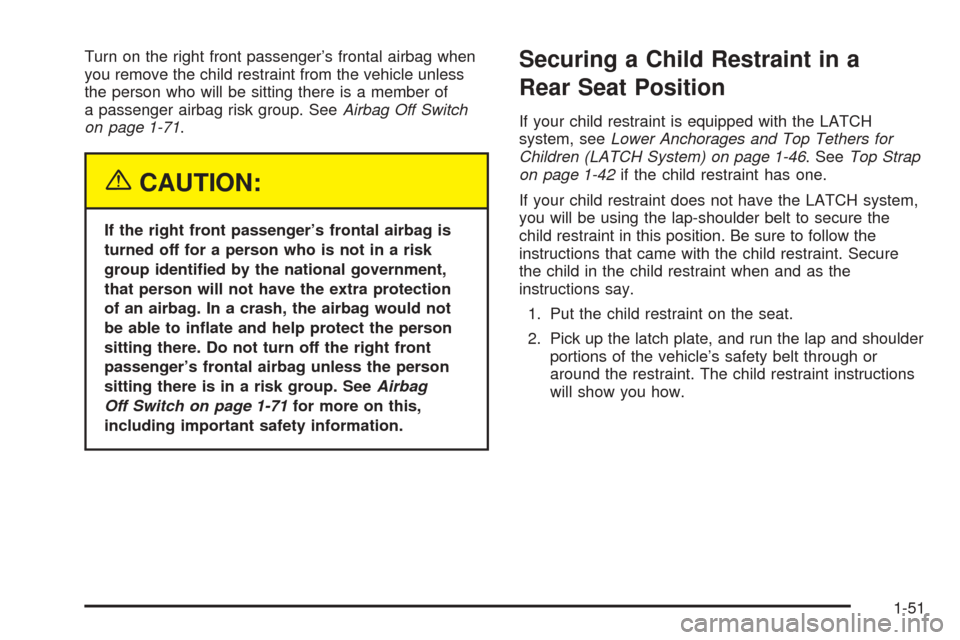
Turn on the right front passenger’s frontal airbag when
you remove the child restraint from the vehicle unless
the person who will be sitting there is a member of
a passenger airbag risk group. SeeAirbag Off Switch
on page 1-71.
{CAUTION:
If the right front passenger’s frontal airbag is
turned off for a person who is not in a risk
group identi�ed by the national government,
that person will not have the extra protection
of an airbag. In a crash, the airbag would not
be able to in�ate and help protect the person
sitting there. Do not turn off the right front
passenger’s frontal airbag unless the person
sitting there is in a risk group. SeeAirbag
Off Switch on page 1-71for more on this,
including important safety information.
Securing a Child Restraint in a
Rear Seat Position
If your child restraint is equipped with the LATCH
system, seeLower Anchorages and Top Tethers for
Children (LATCH System) on page 1-46. SeeTop Strap
on page 1-42if the child restraint has one.
If your child restraint does not have the LATCH system,
you will be using the lap-shoulder belt to secure the
child restraint in this position. Be sure to follow the
instructions that came with the child restraint. Secure
the child in the child restraint when and as the
instructions say.
1. Put the child restraint on the seat.
2. Pick up the latch plate, and run the lap and shoulder
portions of the vehicle’s safety belt through or
around the restraint. The child restraint instructions
will show you how.
1-51
Page 58 of 414
3. Buckle the belt. Make sure the release button is
positioned so you would be able to unbuckle the
safety belt quickly if you ever had to.4. Pull the rest of the shoulder belt all the way out of
the retractor to set the lock (crew cab only).
1-52
Page 59 of 414
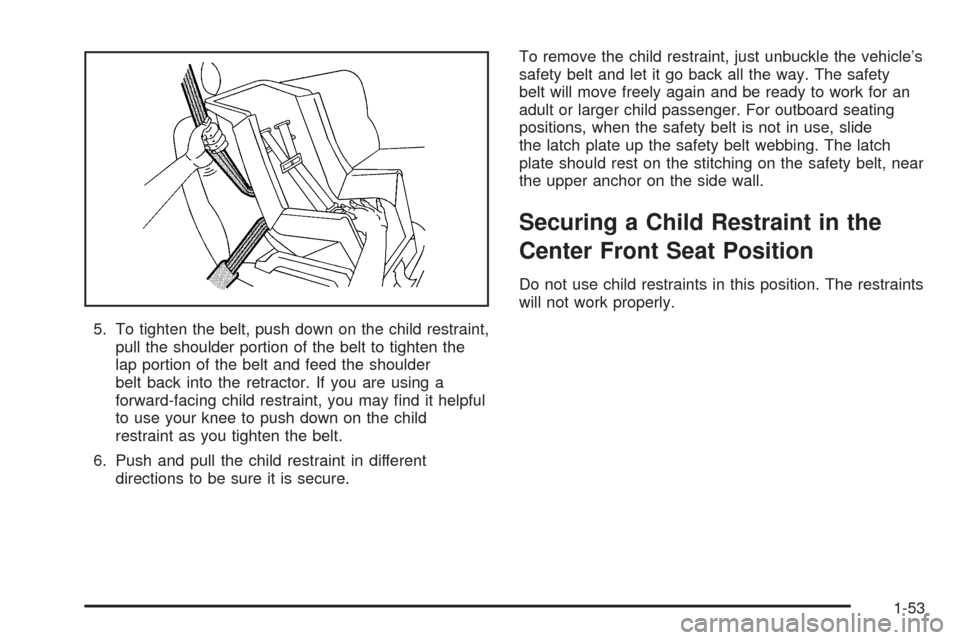
5. To tighten the belt, push down on the child restraint,
pull the shoulder portion of the belt to tighten the
lap portion of the belt and feed the shoulder
belt back into the retractor. If you are using a
forward-facing child restraint, you may �nd it helpful
to use your knee to push down on the child
restraint as you tighten the belt.
6. Push and pull the child restraint in different
directions to be sure it is secure.To remove the child restraint, just unbuckle the vehicle’s
safety belt and let it go back all the way. The safety
belt will move freely again and be ready to work for an
adult or larger child passenger. For outboard seating
positions, when the safety belt is not in use, slide
the latch plate up the safety belt webbing. The latch
plate should rest on the stitching on the safety belt, near
the upper anchor on the side wall.
Securing a Child Restraint in the
Center Front Seat Position
Do not use child restraints in this position. The restraints
will not work properly.
1-53
Page 60 of 414
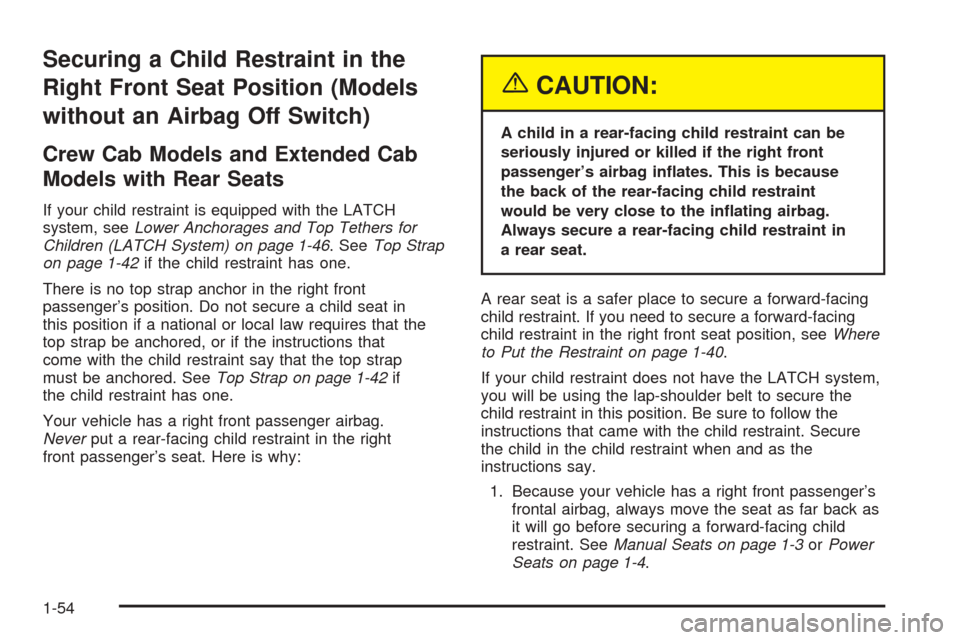
Securing a Child Restraint in the
Right Front Seat Position (Models
without an Airbag Off Switch)
Crew Cab Models and Extended Cab
Models with Rear Seats
If your child restraint is equipped with the LATCH
system, seeLower Anchorages and Top Tethers for
Children (LATCH System) on page 1-46. SeeTop Strap
on page 1-42if the child restraint has one.
There is no top strap anchor in the right front
passenger’s position. Do not secure a child seat in
this position if a national or local law requires that the
top strap be anchored, or if the instructions that
come with the child restraint say that the top strap
must be anchored. SeeTop Strap on page 1-42if
the child restraint has one.
Your vehicle has a right front passenger airbag.
Neverput a rear-facing child restraint in the right
front passenger’s seat. Here is why:
{CAUTION:
A child in a rear-facing child restraint can be
seriously injured or killed if the right front
passenger’s airbag in�ates. This is because
the back of the rear-facing child restraint
would be very close to the in�ating airbag.
Always secure a rear-facing child restraint in
a rear seat.
A rear seat is a safer place to secure a forward-facing
child restraint. If you need to secure a forward-facing
child restraint in the right front seat position, seeWhere
to Put the Restraint on page 1-40.
If your child restraint does not have the LATCH system,
you will be using the lap-shoulder belt to secure the
child restraint in this position. Be sure to follow the
instructions that came with the child restraint. Secure
the child in the child restraint when and as the
instructions say.
1. Because your vehicle has a right front passenger’s
frontal airbag, always move the seat as far back as
it will go before securing a forward-facing child
restraint. SeeManual Seats on page 1-3orPower
Seats on page 1-4.
1-54